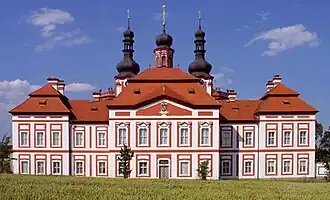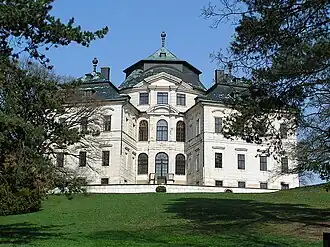Jan Santini Aichel
Jan Blažej Santini Aichel | |
|---|---|
| Born | 3 February 1677 |
| Died | 7 December 1723 (aged 46) Prague, Kingdom of Bohemia |
| Nationality | Czech (of Italian descent |
| Other names | Giovanni Battista Santini Aichel Johann Blasius Santini Aichel |
| Occupation | Architect |
| Practice | Giovanni Battista Santini |
| Buildings | Pilgrimage Church of Saint John of Nepomuk, Church of the Assumption of Our Lady and Saint John the Baptist |
Jan Blažej Santini Aichel, also spelled Aichl (Italian: Giovanni Battista Santini Aichel, German: Johann Blasius Santini Aichel; 3 February 1677 – 7 December 1723) was a Czech architect of Italian descent. His major works are representative of the unique Baroque Gothic style.
Biography
Baptized as Johann Blasius Aichel, Jan Blažej Santini Aichel was born in Prague, Bohemia (now the Czech Republic) on 3 February 1677 (the day of Saint Blaise) to a Czech mother and Italian father as their oldest son. Both his grandfather Antonio Aichel (who moved to Prague from Italy in the 1630s) and his father Santini Aichel belonged to respectable stonemasons. Jan Blažej was born small, hunchbacked and partially lame, preventing him from following in his father's footsteps.[1][2][3]
Around 1696 he started to travel and gain experience. After his journey through Austria he arrived in Rome, where he had the possibility to meet with the work of Francesco Borromini.[4] When Aichel was in Italy, he incorporated his father's given name, Santini, into his name.[1]
Aichel founded his architectural practice in Prague in 1703, attaining the status of a Burgher of Prague in 1705. He bought and rebuilt the Valkounský House in the same year.
Aichel studied painting under the court painter Christian Schröder. He married Schröder's daughter, Veronika Alžběta, in 1707.[2][5] They had four children, but all three sons died from tuberculosis at an early age; the only child left was Anna Veronika (born 1713). Aichel's wife died seven years later and he remarried a South Bohemian noblewoman, Antonia Ignatia Chrapická of Mohliškovice, whereby Aichel was ennobled. Daughter Jana Ludmila and son Jan Ignác Rochus were born from this marriage.
Aichel died at 46, having built over 100 buildings in his twenty-year career, but leaving some unfinished. Although he had become a well-regarded architect to Bohemia's greatest noble families and monastic orders, his original, eclectic style had few successors or imitators.[6]
Honours
The asteroid 37699 Santini-Aichl is named in his honour.
Works
- Monastery Church of the Assumption of Our Lady and Saint John the Baptist in Kutná Hora-Sedlec (reconstruction, 1703–1708, World Heritage Site)
- Chapel of Saint Anne in Panenské Břežany (1705–1707)
- Pilgrimage Church of the Annunciation of the Virgin Mary and Cistercian Provost Office in Mariánská Týnice (1707–1710)
- Convent of the Cistercian Monastery in Plasy (reconstruction, 1711–1723)
- Monastery Church of the Assumption of Virgin Mary, St. Wolfgang and St. Benedict in Kladruby (1711)
- Monastery Church of the Nativity of Virgin Mary in Želiv (reconstruction, 1714–1720)
- Pilgrimage Church of the Name of Virgin Mary in Křtiny (1718)
- Pilgrimage Church of Saint John of Nepomuk on Zelená hora in Žďár nad Sázavou (1719–1727, World Heritage Site)
- Karlova Koruna Chateau in Chlumec nad Cidlinou (1721–1723)
- Church of Saint Wenceslaus in Zvole (reconstruction)
- Church of Saints Peter and Paul in Horní Bobrová (1714)
- Church of the Visitation of Virgin Mary in Obyčtov
- Church of the Assumption of Virgin Mary in Netín
- Provost Church of Saints Peter and Paul in Rajhrad (1721)
- Initial architect for the rebuilding of Zbraslav chateau
- Design and constructions of the Kalec chateau
- Reconstruction of Valkounský House (No.211-III) in Prague-Malá Strana (after 1705)
Gallery
-
 Pilgrimage Church of Saint John of Nepomuk on Zelená hora, a World Heritage Site
Pilgrimage Church of Saint John of Nepomuk on Zelená hora, a World Heritage Site -
 Ground plan of the church on Zelená hora
Ground plan of the church on Zelená hora -
 Church of St. Wenceslaus in Zvole
Church of St. Wenceslaus in Zvole -
Monastery Church of the Assumption of Virgin Mary, St. Wolfgang and St. Benedict in Kladruby
-
 Convent of the Cistercian Monastery in Plasy complex
Convent of the Cistercian Monastery in Plasy complex -
 Interior of the Convent of the Cistercian Monastery in Plasy
Interior of the Convent of the Cistercian Monastery in Plasy -
 Pilgrimage Church of the Annunciation of the Virgin Mary and Cistercian Provost Office in Mariánská Týnice
Pilgrimage Church of the Annunciation of the Virgin Mary and Cistercian Provost Office in Mariánská Týnice -
 Karlova Koruna Chateau in Chlumec nad Cidlinou
Karlova Koruna Chateau in Chlumec nad Cidlinou -
 Original 18th century drawing of Provost Church of Saints Peter and Paul in Rajhrad by Santini
Original 18th century drawing of Provost Church of Saints Peter and Paul in Rajhrad by Santini -
 Stairs of the Church of the Assumption of Our Lady and Saint John the Baptist, Sedlec
Stairs of the Church of the Assumption of Our Lady and Saint John the Baptist, Sedlec
References
- ^ a b "300 years since death of great Czech architect Jan Blažej Santini Aichel". Czech Radio. 2023-12-07. Retrieved 2025-07-21.
- ^ a b "Jan Blažej Santini-Aichel". ArchiWeb (in Czech and English). Retrieved 2025-07-21.
- ^ "Jan Blažej Santini Aichel". Putování za Santinim (in Czech). Retrieved 2025-07-21.
- ^ Fleming, John, ed. (1972). The Penguin Dictionary of Architecture. Harmondsworth: Penguin.
- ^ "Schröder, Kristián". Putování za Santinim (in Czech). Retrieved 2025-07-21.
- ^ Gold, Susan (1984). "Johann Blasius Santini-Aichel: a Gothic-Baroque Architect in Bohemia 1677-1723" (PDF). Transactions of the Ancient Monuments Society / The Journal of Historic Buildings & Places. 29.
Further reading
- Horyna, Mojmír. J. B. Santini-Aichel – Život a dílo. Karolinum, Prague 1998, ISBN 80-7184-664-3.
- Kalina, Pavel. In opere gotico unicus: The Hybrid Architecture of Jan Blazej Santini-Aichel and Patterns of Memory in Post-Reformation Bohemia.Praha: UMENI-ART 58.1 (2010): 42-+.
- Young, Michael. Santini-Aichel'S Design for the Baroque Convent at the Cistercian. New York: Columbia, 1994.
External links
- Santini-Aichel: life, work and architecture at the Wayback Machine (archived 25 February 2008)